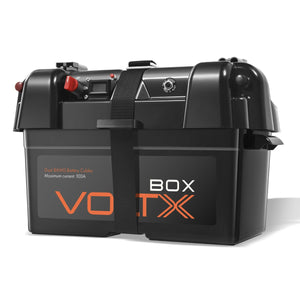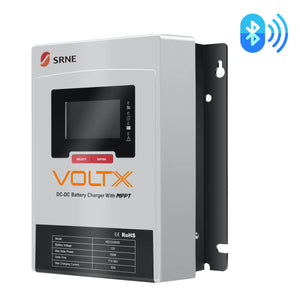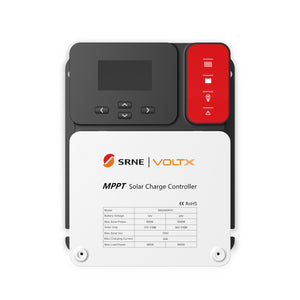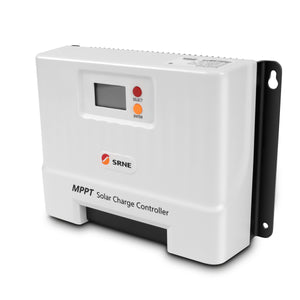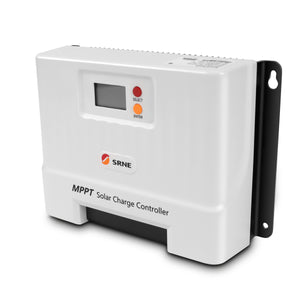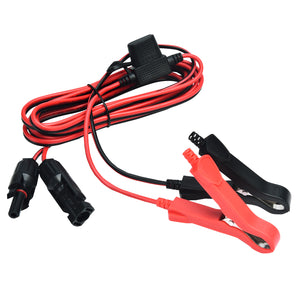VoltX SRNE 12V 30A DC-DC MPPT LiFePO4 Battery Charger with Bluetooth
$319.99Unit price /UnavailableVoltX SRNE 12V 50A DC-DC MPPT LiFePO4 Battery Charger with Bluetooth
$359.99Unit price /Unavailable
Lithium Battery Accessories Built for Australian Conditions
The world of off-grid power has evolved dramatically in recent years, with lithium battery technology leading the charge. Whether you're planning an extended camping trip through the Australian outback or setting up a reliable power system for your caravan, having the right lithium battery charger and accessories is crucial for maintaining consistent, dependable power. From high-efficiency DC-DC chargers that work seamlessly with your vehicle's alternator to sophisticated MPPT solar chargers that maximise energy harvest from your panels, the accessories you choose can make the difference between a frustrating power shortage and an effortlessly powered adventure. At Outbax, we understand that Australian outdoor enthusiasts need reliable charging solutions that can withstand our unique conditions while delivering optimal performance for their lithium battery systems.
Why Specific Lithium Battery Accessories Matter
Unlike traditional lead-acid batteries, lithium batteries—particularly LiFePO4 variants—require specialised charging protocols to ensure safety, longevity, and peak performance. Standard chargers designed for other battery types can cause irreversible damage to lithium cells by failing to manage the critical constant current and constant voltage stages, or by neglecting the essential cell balancing process that keeps all cells within your battery pack operating harmoniously. "The chemistry of lithium batteries demands precision," notes battery technology expert James Patterson. "Using inappropriate charging equipment is like trying to fuel a diesel engine with petrol—it simply won't work properly and can cause serious damage."
This becomes especially critical in remote Australian locations where reliable power isn't just convenient but essential for safety. Quality lithium battery accessories incorporate sophisticated battery management system chargers that monitor individual cell voltages, prevent overcharging, and ensure your investment in lithium technology delivers the promised 10+ year lifespan. When you're hours from civilisation, having battery charging solutions specifically engineered for lithium chemistry isn't just about efficiency—it's about peace of mind knowing your power system will perform when you need it most.
Selecting Your Ideal Lithium Battery Charger
Choosing the right lithium battery charger depends largely on your power source and specific application, with each type offering distinct advantages for different scenarios. AC chargers, such as the Victron lithium battery charger series, excel when you have access to mains power at home or powered campsites, providing rapid, efficient charging with sophisticated multi-stage algorithms designed specifically for LiFePO4 battery chemistry. For those constantly on the move, a DC to DC charger lithium system transforms your vehicle's alternator into a mobile charging station, with advanced models like the VoltX DC-DC charger featuring MPPT technology that can simultaneously accept solar input—essentially giving you a DC to DC charger with solar input lithium capability that maximises charging from multiple sources.
The voltage and amperage specifications are equally crucial: a 12 volt lithium battery charger must match your battery bank's configuration, while the amperage rating determines charging speed, remembering that a properly sized charger for a 200Ah battery bank typically ranges from 20A to 40A for optimal performance without stressing the cells. Whether you need a straightforward 240V lithium battery charger for workshop use or a sophisticated DC-DC MPPT LiFePO4 battery charger for your touring setup, understanding these distinctions ensures you select equipment that not only charges effectively but also protects your investment. Many Australian adventurers find that combining charger types—perhaps a quality battery charger for lithium batteries at home and a robust camping battery charger or RV lithium charger for the road—provides the ultimate flexibility for any power scenario.
Understanding Other Essential Battery Parts
Beyond chargers, a complete lithium battery system relies on several crucial accessories that enhance functionality, safety, and convenience. Battery monitoring displays, such as the VoltX Inverter LCD Display, provide real-time visibility into your power system's health. It shows vital statistics like voltage, current draw, remaining capacity, and even predictive runtime based on current usage patterns—invaluable information when managing limited power resources in remote locations. Equally important are the often-overlooked connectors and cables that form the backbone of your electrical system; products like the MC4 to Alligator Clip Connector, a long 2.4m cable built from high-quality, weatherproof materials, making it ideal for outdoor and off-grid power setups, and enabling seamless integration between solar panels and battery banks.
Heavy-duty cables ensure minimal voltage drop and maximum efficiency in power transfer. These accessories might seem mundane compared to high-tech chargers but experienced off-grid enthusiasts know that a loose connection or undersized cable can cripple an otherwise perfect setup. Quality battery monitor displays also help identify potential issues before they become critical, alerting you to problems like cell imbalance or unexpected power draws that could leave you stranded without power. When building or upgrading your lithium battery system, investing in professional-grade connectors, monitoring equipment, and properly rated cables ensures every component works together harmoniously, delivering the reliable performance that modern lithium technology promises.
Important Factors Before You Purchase
Making informed purchasing decisions requires careful consideration of several critical specifications and compatibility factors unique to your setup. First and foremost, verify battery chemistry compatibility. While most modern lithium systems use LiFePO4 cells, some older or specialised applications might use different lithium variants that require specific charging profiles. The question of "what size charger for 200ah battery" exemplifies the importance of matching charger capacity to your battery bank. Generally, charging at 0.2C to 0.5C (20% to 50% of battery capacity) provides the best balance between charging speed and battery longevity, meaning a 200Ah battery ideally pairs with a 40A to 100A charger depending on your needs.
Need a recommendation? The VoltX SRNE 12V 30A DC-DC MPPT LiFePO4 Battery Charger (Model MD1230N05) is a high-efficiency charging solution designed to support a wide range of battery types, including sealed, gel, vented, lithium iron phosphate, and user-defined batteries. Engineered for both solar and generator charging, it features a 30A charging current, MPPT efficiency over 99%, and supports solar panel input up to 400W with a maximum input voltage of 55V DC. Built for versatility and durability, the charger offers advanced buck, boost, and buck-boost charging modes, operates reliably in extreme temperatures (–35°C to 65°C), and includes a 3-year warranty.
Power source availability dramatically influences charger selection—those with consistent access to mains power might prioritise a high-output AC charger, while overlanders often prefer versatile DC-DC units that charge whilst driving, and solar enthusiasts need MPPT controllers for maximum panel efficiency. Installation requirements shouldn't be overlooked either; some setups demand specific mounting configurations, ventilation considerations, or additional components like temperature sensors for optimal performance in extreme conditions.
Quality brands matter immensely in this space. For instance, trusted names like Victron and VoltX have earned reputations for reliability in demanding Australian conditions through rigorous testing and proven field performance. Before finalising any purchase, consider your entire power ecosystem: how your batteries, chargers, monitoring systems, and loads will work together to create a cohesive, reliable system that meets both current needs and allows for future expansion.
Getting the Right Gear for Your Setup
Investing in quality, purpose-built lithium battery accessories transforms your off-grid power experience from a constant concern to a reliable, efficient system that simply works. The right combination of chargers, monitors, and connectors ensures your expensive lithium batteries deliver their full potential, providing thousands of cycles of dependable power, whether you're exploring remote beaches, setting up camp in the high country, or simply wanting backup power at home. Australian outdoor enthusiasts particularly benefit from this reliability, as our vast distances and extreme conditions demand equipment that won't let you down when it matters most.
Quality accessories also protect your investment; a properly configured system with appropriate charging equipment and monitoring can extend battery life significantly, often doubling or tripling the lifespan compared to systems using generic components. As you explore the range of lithium battery chargers and accessories available, remember that each component plays a vital role in creating a power system that matches your specific adventures and requirements—there's no one-size-fits-all solution, but with the right knowledge and quality components, you can build a system perfectly tailored to your needs.
Frequently Asked Questions
-
What type of charger do I need for my lithium battery?
The type of lithium battery charger you need depends on your power source and battery specifications. For home or workshop charging with mains power, an AC charger designed for lithium chemistry works best. If you're charging from a vehicle while travelling, a DC-DC charger is essential. Solar users need an MPPT charger specifically programmed for lithium batteries. Always match the charger voltage (12V, 24V) to your battery system and ensure it's rated for LiFePO4 or your specific lithium chemistry.
-
What is the difference between an AC and a DC-DC lithium charger?
AC chargers plug into standard 240V mains power and convert it to the appropriate DC voltage for charging your batteries—ideal for home or powered site use. DC-DC chargers, conversely, take power from your vehicle's alternator or another DC source and boost or regulate it to charge your auxiliary lithium battery whilst driving. Many modern DC-DC units also incorporate solar input capabilities, making them incredibly versatile for mobile applications.
-
How do I choose the right size charger for my battery bank?
Determining what size charger for a 200Ah battery or any capacity involves balancing charging speed with battery health. A general rule suggests charging at 0.2C to 0.5C—for a 200Ah battery, this means a 40A to 100A charger. Slower charging extends battery life, whilst faster charging provides convenience. Consider your typical usage patterns and available charging time when selecting charger capacity.
-
Are these chargers compatible with all lithium battery types?
Not all lithium chargers work with every lithium battery type. Most modern chargers are optimised for LiFePO4 (Lithium Iron Phosphate) batteries, which dominate the RV and solar market. However, lithium-ion (Li-ion) and other variants may require different charging profiles. Always verify compatibility between your specific battery chemistry and the charger's programmed profiles before purchasing.
-
Can I use a lead-acid charger for my lithium battery?
No, using a lead-acid charger on lithium batteries is strongly discouraged and can be dangerous. Lead acid chargers lack the precise voltage control, current limiting, and cell balancing features essential for lithium batteries. They may overcharge lithium cells, potentially causing permanent damage, reduced lifespan, or safety hazards. Always use chargers specifically designed for your lithium battery type.
-
What is an MPPT solar charger, and do I need one?
MPPT (Maximum Power Point Tracking) solar chargers optimise the power harvested from solar panels by continuously adjusting the electrical operating point. For lithium batteries, an MPPT charger with lithium-specific charging profiles maximises solar efficiency whilst protecting your batteries. If you're using solar panels with your lithium system, an MPPT charger typically provides 20-30% more charging power than basic PWM controllers.
-
How do I connect an MC4 to an Alligator clip connector?
Connecting an MC4 to an Alligator Clip Connector is straightforward: the MC4 ends click directly onto your solar panel's MC4 connectors (ensuring correct polarity), whilst the alligator clips attach to your battery terminals or bus bars—red to positive, black to negative. These 8ft cables provide flexibility in positioning panels whilst maintaining a secure, weatherproof connection at the panel end.
-
What does a battery monitor display show me?
A battery monitor display provides comprehensive real-time data about your power system, including current battery voltage, amp draw (how much power you're using), state of charge percentage, and often historical data like amp-hours consumed. Advanced monitors can predict remaining runtime at current usage rates and alert you to potential issues like voltage drops or excessive discharge rates.
-
How long will it take to charge my 200Ah lithium battery?
Answering how long to charge a 200Ah battery depends on your charger's output and the battery's current state. With a 40A charger, expect roughly 5-6 hours from empty to full. A 20A charger would take 10-12 hours, whilst a 100A charger could complete the job in 2-3 hours. These times assume charging from a completely flat state, though in practice, most charging occurs from partially depleted states.
-
What voltage charger do I need for a 12V lithium battery?
A 12V lithium battery requires a charger that outputs the correct charging voltage for lithium chemistry, typically 14.4V to 14.6V for LiFePO4 batteries during the absorption phase. The charger must be specifically designed for 12V lithium systems, as using 24V or higher voltage chargers will damage your battery. Always match the charger's output voltage rating to your battery system's nominal voltage.
-
Are Victron and VoltX chargers reliable options?
Both Victron and VoltX have established strong reputations in the Australian market for producing reliable, high-quality lithium battery chargers. Victron products are known for their robust construction and advanced features, whilst VoltX offers excellent value with proven performance in Australian conditions. Both brands provide comprehensive warranties and have widespread support networks across Australia.
-
Can I charge a lithium battery while also using power from it?
Yes, most lithium battery systems support simultaneous charging and discharging, often called "pass-through" operation. Quality lithium chargers and battery management systems handle this automatically, prioritising loads whilst using excess charging capacity to replenish the battery. This feature proves particularly valuable in solar systems where daytime loads can run directly from solar, whilst excess energy charges the battery for night use.
Frequently Asked Questions
- What type of charger do I need for my lithium battery?
- What is the difference between an AC and a DC-DC lithium charger?
- Are Victron and VoltX chargers reliable options?
- Can I charge a lithium battery while also using power from it?
- How do I choose the right size charger for my battery bank?
- Are these chargers compatible with all lithium battery types?
- Can I use a lead-acid charger for my lithium battery?
- What is an MPPT solar charger, and do I need one?
- How do I connect an MC4 to an Alligator clip connector?
- What does a battery monitor display show me?
- How long will it take to charge my 200Ah lithium battery?
- What voltage charger do I need for a 12V lithium battery?
